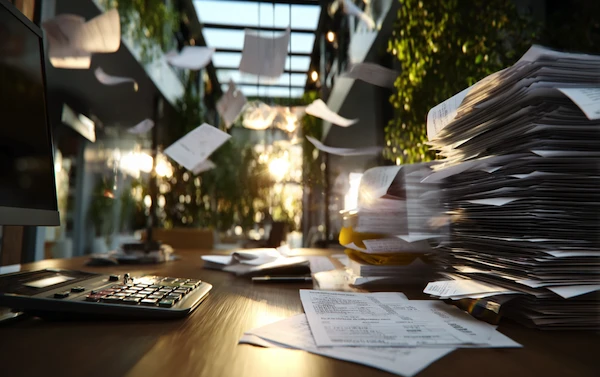Supplier Statement Reconciliation: A Complete Guide

Accounts payable teams face mounting pressure to maintain accurate financial records while processing increasing transaction volumes with limited resources. Supplier statement reconciliation represents one of the most critical yet time-consuming processes in this environment, with many organizations reconciling only their largest vendors due to manual process constraints.
The cost of incomplete reconciliation extends far beyond missed credits and duplicate payments. Organizations risk damaged supplier relationships, inaccurate financial reporting, and significant working capital inefficiencies when discrepancies go unidentified. This comprehensive guide explores how to transform vendor reconciliation from a reactive, manual process into a strategic advantage that protects profits and strengthens supplier partnerships.
Coming Up
What is Supplier Statement Reconciliation?
Supplier statement reconciliation is the process of comparing statements received from vendors against your organization’s internal accounts payable records to identify and resolve discrepancies. Supplier statements are typically generated from the supplier's accounting software, which helps manage transactions and records. This essential financial control ensures accurate records of transactions, payments, and outstanding balances between your company and its suppliers.
The process involves systematically matching each transaction on a supplier's statement, which covers a specific period, with corresponding entries in your purchase ledger. The reconciliation process begins by checking the opening balance on both the supplier's statement and your internal records to ensure they match. A supplier's statement represents your account from the supplier’s viewpoint, while your organization may record transactions at different times based on invoice receipt and approval workflows.
Consider this example: The statement provided by the supplier covers a specific period and shows an opening balance, an invoice for $2,500, a credit note for $150, and a payment of $1,000, leaving a balance of $1,350. However, your accounts payable system shows only the original invoice and payment, resulting in a balance of $1,500. The reconciliation process identifies the missing $150 credit note, protecting your organization from overpaying while maintaining accurate financial records.
Why Supplier Statement Reconciliation is Important
Accounts payable reconciliation protects organizations from costly financial errors while strengthening operational efficiency. Without regular vendor reconciliation, companies face systematic overpayments, missed savings opportunities, and damaged supplier relationships.
Preventing Financial Losses
Reconciliation identifies missing credit notes, duplicate payments, and billing errors before they impact cash flow. Regular statement reconciliations help prevent further errors from accumulating and becoming more difficult to resolve. One organization discovered nearly £2 million in recoverable amounts simply by implementing consistent supplier reconciliation practices. These discrepancies accumulate quickly - a company processing 1,000 monthly invoices with just 2% errors faces 20 potential problems each month, but automating the reconciliation process can save time and reduce the risk of late payments.
Supporting Financial Planning and Compliance
Accurate supplier balances enable better cash flow forecasting and budget planning. Accurate supplier statement reconciliations support informed decision making by ensuring accurate ledgers and ledger accuracy. Vendor reconciliation ensures month-end closing accuracy and provides audit-ready documentation that demonstrates effective financial controls. This preparation reduces restatement risks and satisfies auditor requirements for accounts payable oversight.
Strengthening Supplier Relationships
Proactive reconciliation prevents disputes that damage business partnerships. Suppliers appreciate customers who identify billing errors quickly, often resulting in better payment terms and priority treatment. Regular supplier reconciliations and prompt responses to supplier queries help maintain strong supplier relationships by ensuring accuracy and timely resolution of issues. Organizations that discover discrepancies months later face more difficult conversations and potential relationship strain.
Accounts payable reconciliation transforms a reactive, problem-solving approach into proactive financial management that protects working capital and supports strategic business objectives.
Common Issues & Discrepancies Found During Reconciliation
Even well-managed accounts payable departments encounter reconciliation statement issues during the vendor reconciliation process. Understanding these common discrepancies helps teams identify problems quickly and implement preventive measures.
Invoice Mismatches and Entry Errors
Invoice number discrepancies represent the most frequent reconciliation challenge. Suppliers may reference invoices differently than how they appear in your system, or invoices may be entered with incorrect amounts due to data entry errors. Miss postings can occur when transactions are entered incorrectly, leading to discrepancies or errors in the ledger that need resolution. Automated statement matching can help prevent these errors by streamlining invoice reconciliation and reducing manual efforts. Transposition errors - such as entering $1,450 instead of $1,540 - create persistent balance differences that require careful investigation.
Currency conversion errors compound these problems for organizations dealing with international suppliers. When invoices are processed in different currencies, exchange rate timing differences or incorrect conversion rates can create significant discrepancies that affect both individual transactions and overall balances.
Missing Credit Notes and Unprocessed Adjustments
Credit notes frequently cause reconciliation statement issues because they may be issued by suppliers but not received or processed by the customer’s accounts payable team. These credits for returned goods, billing corrections, or promotional adjustments remain outstanding on supplier statements while missing from internal records. Missing credits and open invoices can lead to aged balances and financial inaccuracies if not promptly reconciled.
Similarly, negotiated discounts, volume rebates, or settlement adjustments may appear on supplier statements before they are processed internally, creating temporary but significant balance differences. Ensuring all goods receipts have been invoiced helps reduce outstanding balances and improve accuracy.
Timing Differences and Processing Delays
Payment timing creates natural discrepancies when payments are recorded in your system before suppliers receive and process them. A check sent on month-end may not reach the supplier's accounting system until the following period, causing apparent balance differences.
Invoice processing timing also creates issues. Suppliers may issue invoices immediately upon shipment while your organization records them only upon receipt and approval, leading to temporary reconciliation differences.
Human Error and System Limitations
Manual data entry introduces errors in invoice amounts, supplier codes, and payment allocations. Staff may accidentally apply payments to wrong supplier accounts or enter partial payment amounts incorrectly. High workloads on AP teams can lead to further errors, making it essential to have an expert team overseeing the reconciliation process.
System limitations can prevent proper matching when supplier invoice numbering doesn’t align with your accounts payable system requirements, or when automated matching rules fail to accommodate supplier-specific billing practices.
When you reconcile vendor statements regularly, these common issues become manageable problems rather than accumulating financial risks.
Step-by-Step: How to Reconcile a Supplier Statement
Learning how to reconcile a supplier statement effectively requires a systematic approach that ensures accuracy while maintaining efficiency. This reconciliation process follows seven essential steps that protect your organization from financial errors.
Step 1: Gather Required Documents
Collect the supplier statement for the reconciliation period along with supporting documentation from your accounts payable system. Essential documents include purchase orders, supplier invoices, credit notes, payment records, and any prior reconciliation reports. Having access to view invoice and payment status helps ensure all transactions are accounted for during reconciliation. Ensure you have the correct statement period and that all documents are complete before beginning.
Step 2: Match Statement Entries to Internal Records
Compare each transaction on the supplier statement against your accounts payable ledger line by line. Match invoices by number, amount, and date, then verify that payments and credits appear correctly in both systems. To ensure complete accuracy, matching entries should also be verified against both the general ledger and AP ledgers. Flag any entries that don’t have corresponding matches for further investigation.
Step 3: Investigate Discrepancies
Analyze unmatched items to determine root causes. Check for transposition errors, incorrect supplier codes, or timing differences between when transactions were recorded in each system. Review supporting documentation like delivery receipts or payment confirmations to understand the source of differences.
Step 4: Communicate with Supplier
Contact the supplier's accounts receivable team to clarify discrepancies that cannot be resolved internally. Prepare specific questions about missing invoices, credit notes, or payment applications. Document all communications including dates, contact names, and agreed-upon resolutions.
Step 5: Update Your System
Process necessary adjustments in your accounts payable system based on reconciliation findings. This may include entering missing invoices, applying unrecorded credits, or correcting payment allocations. Ensure all updates include proper supporting documentation and approval codes.
Step 6: Document the Reconciliation
Create a reconciliation report showing the starting balance, identified adjustments, and final reconciled balance. Include explanations for all discrepancies and their resolutions. Automated systems can generate reports and assign an overall status to each reconciliation, indicating whether it is complete, pending, or requires further attention. This documentation supports audit requirements and provides reference for future reconciliations.
Step 7: Obtain Internal Approval
Submit the completed reconciliation for review and approval according to your organization's authorization matrix. Senior staff should verify that adjustments are appropriate and that the reconciliation process has been completed thoroughly before finalizing.
Manual vs Automated Reconciliation: A Comparison
Organizations face a critical decision between manual processes and statement reconciliation software that directly impacts both accuracy and operational efficiency.
Manual Reconciliation Trade-offs
Manual reconciliation provides complete control and flexibility for handling complex supplier formats and unusual transactions. However, the process consumes substantial time - reconciling a single high-volume supplier can take hours or days, limiting most teams to reconciling only their largest vendors. Manual matching also increases error rates and creates inconsistent results.
The Automation Advantage
Statement reconciliation software transforms the reconciliation timeline from hours to seconds while enabling 100% supplier coverage rather than spot-checking top accounts. Automation reconciliation eliminates human matching errors and provides consistent audit documentation.
Automated systems struggle with non-standard formats but excel at high-volume, routine reconciliations.
Cost and Productivity Impact
Manual errors accumulate into significant financial losses. One organization recovered nearly £2 million in missed credits after implementing systematic reconciliation. The opportunity cost proves equally important - staff spending days on manual reconciliation cannot focus on strategic activities like vendor relationship management.
Statement reconciliation software enables accounts payable teams to shift from reactive problem-solving to proactive financial management, catching discrepancies before they become costly disputes or missed savings opportunities.
How Solvexia Automates Supplier Reconciliation
Solvexia transforms supplier statement reconciliation through AI-powered automation that completes reconciliations 100x faster while reducing errors by 98%. The platform's unified data engine automatically combines data from your ERP, accounts payable system, and supplier statements, then uses intelligent matching to handle complex one-to-many and many-to-many scenarios in seconds rather than hours.
Organizations like 7-Eleven Philippines cut their reconciliation process from days to minutes while processing over 500,000 daily transactions. The solution intelligently routes exceptions to staff for investigation while providing executive dashboards for real-time visibility across all suppliers, enabling teams to achieve positive ROI within 6-12 months by focusing on strategic analysis rather than manual matching tasks.
Best Practices for Supplier Reconciliation
Follow these best practices during your supplier statement reconciliation process:
1. Reconcile Regularly
To ensure accuracy and catch discrepancies early, prioritize reconciling your highest-value suppliers monthly. Focus on vendors representing 80% of your spend, as these suppliers present the greatest financial risk. Smaller suppliers can be reconciled quarterly, but high-transaction vendors require more frequent attention to prevent errors from accumulating.
2. Use Technology
Using finance automation software like Solvexia can streamline the vendor reconciliation process by automating matching tasks, reducing human error, and providing real-time visibility into discrepancies.
Solvexia helps businesses maintain consistency and accuracy in supplier reconciliation by automating complex matching scenarios and providing intelligent insights into exceptions, making reconciliations up to 100x faster with 98% fewer errors.
3. Maintain Clear Documentation
Keep detailed communication logs for all supplier interactions during reconciliation. Document discrepancy investigations, resolution agreements, and follow-up commitments. This transparency supports auditing requirements and ensures accountability when similar issues arise with future reconciliations.
4. Investigate Discrepancies Promptly
When reconciliation statement issues arise, investigate them immediately to determine root causes. Delaying investigation can strain supplier relationships and allow errors to compound. Look for missing credit notes, duplicate payments, or billing errors, and reconcile vendor statements before discrepancies escalate into disputes.
5. Establish Digital Audit Trails
Store reconciliation reports, supporting documentation, and approval records in organized digital systems. Ensure complete process documentation from initial data gathering through final approval for quick retrieval during audits or dispute resolution.
6. Monitor Performance Metrics
Track reconciliation completion rates, average resolution times, and types of discrepancies identified across all suppliers. Regular metrics review reveals process improvement opportunities and helps justify automation investments by demonstrating the cost of manual reconciliation inefficiencies.
Final Thoughts: The Future of Supplier Reconciliation
Supplier statement reconciliation is evolving from a manual compliance task into a strategic enabler of financial excellence. As automation handles routine matching, accounts payable teams are transforming into financial analysts focused on exception investigation, supplier performance analysis, and process optimization. This shift enables organizations to reconcile 100% of suppliers rather than limiting efforts to top vendors, uncovering hidden savings and preventing costly errors across the entire supplier base.
No-code platforms like Solvexia democratize reconciliation automation, enabling finance teams to build and modify vendor reconciliation workflows without IT dependency. This flexibility supports continuous improvement as business requirements evolve and integrates reconciliation insights with broader finance transformation initiatives including cash flow forecasting, working capital optimization, and supplier risk management. The future belongs to organizations that combine intelligent automation with human expertise, creating scalable processes that maintain the nuanced judgment required for complex supplier relationships.
FAQ
Intelligent reconciliation solution
Intelligent rebate management solution
Intelligent financial automation solution
Intelligent Financial Automation Solution
Intelligent financial automation solution
Intelligent financial automation solution
Intelligent financial automation solution
Intelligent financial automation solution
Intelligent regulatory reporting solution
Free up time and reduce errors
Recommended for you

Request a Demo
Book a 30-minute call to see how our intelligent software can give you more insights and control over your data and reporting.

Reconciliation Data Sheet
Download our data sheet to learn how to automate your reconciliations for increased accuracy, speed and control.

Regulatory Reporting Data Sheet
Download our data sheet to learn how you can prepare, validate and submit regulatory returns 10x faster with automation.

Financial Automation Data Sheet
Download our data sheet to learn how you can run your processes up to 100x faster and with 98% fewer errors.

Financial Automation Data Sheet
Download our data sheet to learn how you can run your processes up to 100x faster and with 98% fewer errors.

Financial Automation Data Sheet
Download our data sheet to learn how you can run your processes up to 100x faster and with 98% fewer errors.

Financial Automation Data Sheet
Download our data sheet to learn how you can run your processes up to 100x faster and with 98% fewer errors.

Financial Automation Data Sheet
Download our data sheet to learn how you can run your processes up to 100x faster and with 98% fewer errors.

Financial Automation Data Sheet
Download our data sheet to learn how you can run your processes up to 100x faster and with 98% fewer errors.

Rebate Management Data Sheet
Download our data sheet to learn how you can manage complex vendor and customer rebates and commission reporting at scale.

Top 10 Automation Challenges for CFOs
Learn how you can avoid and overcome the biggest challenges facing CFOs who want to automate.
.svg)



